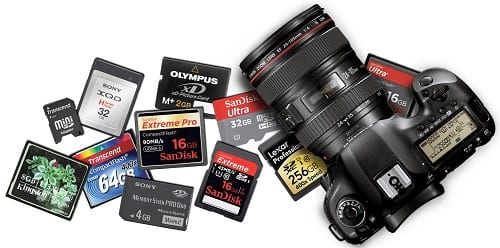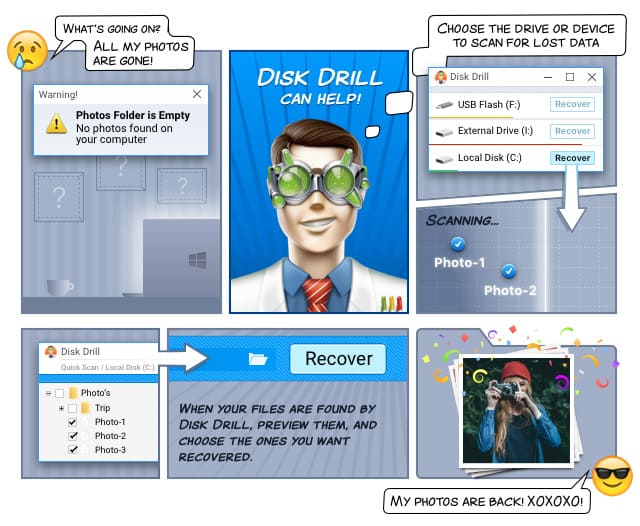What is a memory card and is data recovery possible?
What is a memory card? A memory card is known to be a small storage medium which is generally used to store information. The most common type of data that’s being stored on a memory card include videos, pictures, audio and other types of file formats. It’s also used for smaller, portable as well as remote computer devices. The majority of the current products are going to use flash memory, even though there are other technologies which are currently under development.

What is an SD memory card?
There are a few different types of memory card so that’s why the answer to the questions what is the best memory card is going to require a bit more effort to get right. So, with this in mind, an SD memory card stands for secure digital card and it’s a tiny memory card which is used to make storage portable throughout different devices. It also features, particularly high data transfer rate as well as low battery consumptions. These are particularly important for mobile and portable devices. On the other hand, it uses flash memory in order to provide the user with a nonvolatile storage. This, from its part, means that a power source wouldn’t be required in order to retain the data which is being stored. It’s safe to say that this might be the answer to the questions what is the best memory card.
What is a memory card used for?
There are plenty of different uses for a memory card. Let’s take the most obvious one. You buy a high-def camera which is capable of taking mesmerizing pictures. However, you only get 8GB of built-in storage space which isn’t going to do you much good because an HD picture could easily get up to a few megabytes. With this in mind, you’d be capable of taking a few hundred pictures before running out of space to use and that’s pretty inconvenient. You would have to consider deleting pictures you love in order to make room for new ones.
Sure, you can connect your camera to the computer and unload all the information on it, but what if this happens while you are working outside or when you are someplace else and you don’t have your PC or Mac with you? That’s when a memory card is going to come in quite handy.
However, issues are capable of arising. Understanding what is a flash memory card is definitely going to give you a certain edge when recovering certain lost data, but you would have to rely on some sort of restoration software. This is where Disk Drill comes to extend a helping hand. The first thing that you need to understand about this particular software is that it’s pretty comprehensive and it doesn’t presume any high-level of technical knowledge on behalf of the user. It targets all sorts of people regardless of how well they can use a computer or whether they can use one at all. Furthermore, after understanding what is a memory card, you’d definitely be a bit prepared as to what to expect. So, without any further ado, let’s take a look at the steps that you’d need to follow to make sure that your information is safely restored.
Step #1 Considerations for you to account for
The first thing that you might want to do is to assess the situation. The less you use your memory card, the bigger your chances to recover information are. The majority of cameras wouldn’t really wipe pictures from a camera upon deleting or formatting – they’d only delete the file names and the information remains on the memory card until it’s being overwritten.
Step #2 Download the software
Of course, in order to use it, you’d have to download the Disk Drill software from the website. It’s important that you use Mac OS 10.6.8 or a newer one. Once you’ve managed to download the software, locate it and launch it.

Step #3 Connect the memory card
This could happen by connecting your camera while you have the memory card inserted or if you have a particular device called a card-reader. Regardless, you would need to plug any one of those into the computer in order for it to be able to pick up the necessary information and restore the data.
Step #4 Scan the memory card
Using Disk Drill is particularly easy in this regard. You get to choose between different scanning methods which are usable if you have different preferences and requirements. Quick Scan could be used if you don’t have so many files you want to recover while if the amount of information is larger, you can use the Deep Scan option. It’s all pretty intuitive and you wouldn’t have to dig in order to find the right type of scan method.
Step #5 Recover
The last thing you’d need to take care of is to recover the files that have been listed. Once the scan is completed, you’d be provided with all the files which are eligible for recovery. A quick tip here for all those who prefer to go with the Quick Scan mode – sometimes you might want to go ahead and Deep Scan the memory card just to ensure that all the files are listed properly. Once you go through the list, you can easily select the files that you want to recover and hit the “Recover” button – it’s as easy as this.
In any case, you might want to learn the basics behind what is a memory card and how to use it properly so you don’t have to fall within situations of the kind in the first place. Of course, you can rely on Disk Drill to go through your memory card and get all the files which are capable of being restored. In conclusion, the tool is pretty intuitive and it might be one of your best choices if you’ve accidentally lost your information.
